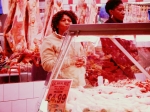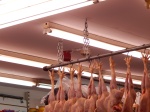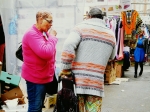In september 15, 2015 I visited the photographs section of the V&A Museum in London, “The Exhibit”. During my visit I considered that from all the pieces in the gallery, Iran Untitled by Gohar Dashti was the most impacting, funny, and touching series of photographs. The artist, Gohar Dashti, was born in Ahvaz, Iran in 1980 but lives in Tehran where she got hers M.A in Photography from the Fine Art University of Tehran in 2005. Her work has been exhibit in many museums such as Mori Art Museum in Tokyo, the Fine Art Museum in Boston, the National Taiwan Museum of Fine Art, the Devi Art Foundation in Gurgaon and the Grimmuseum in Berlin. In Her work she portrays the history and society of her native country. Not only she shows the Iranians culture, politics and societal rules, but she did it in a satirical way, referring to serious cultural and historical events with a bit of fun and humor showing the Iranians personality. Her photographs ended up being funny and moving all at the same time.
The scenario of this piece is placed on Tehran, Iran. The landscape in her pictures is isolated with nothing more than just a few patches of dirt color, almost dead grass. There is nothing around, no trees or buildings. The background is uniform in color and the sky is grey. This gives a sense of nostalgia almost sadness but it also makes the eye focus on the center of the image. In the middle of the this landscape there is a set of people portraying either the feelings of the artist or showing Iranians usual cultural activities and people’s lives. I believe this is impacting and what makes the pieces so successful. Having an escenario as a weeding or people playing happening in the middle of nowhere, in a desertic area makes you wonder what is happening, catches your attention to the piece and makes you want to know more about its symbolism.
Her work is based on the historical event between the Islamic Revolution of 1979 and the violent Iran-Iraq war, 1980-1988. One of my favorite pieces was the picture in which the Iranians were standing with bags waiting in line in the middle of the desert to nowhere to go. Researching about her work, critics say that this picture represents the contradictory want that is set between the wish to move on and the desire of maintaining their cultural fundamentalist Islamic traditions. This work at first sight is somewhat humoristic, seeing people standing in the middle of the desert, respectfully waiting in line with bags but at the same time it touches a deeper meaning, showing a cultural struggle and a serious situation in which Iranians had to lose their identity in order to move on. Her view on the history of her country and its contradictions is what inspire the creation of these photographs. I was really inspired and I can not wait to see more of her work.



















